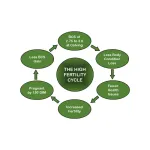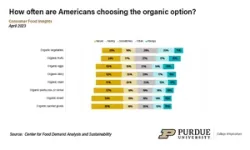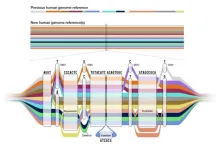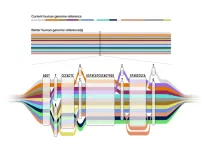(Press-News.org) Philadelphia, May 10, 2023 – The dairy industry has seen a revolution over the past two decades in fertility success within herds. Widely adopted fertility programs are at the heart of this leap forward, along with the industry’s increased understanding—and optimization—of the holistic interactions among the body condition, overall health, and fertility of a dairy cow. In a recent mini-review appearing in a special fertility issue of JDS Communications®, published by Elsevier, researchers from the University of Wisconsin–Madison and Michigan State University synthesize the past three decades of scientific research explaining these relationships and highlight the key actionable takeaways for establishing and maintaining high fertility for a dairy herd.
Richard Pursley, PhD, of Michigan State University, one of the co-authors, initially coined the term “high fertility cycle” to describe this understanding of the interrelated factors on a dairy farm that interact to create fertility success.
“After the last two or more decades of research,” explained Pursley, “we now know that reproductive success is tied to other health markers in a dairy herd, and we set out to show how this knowledge can be utilized to maximize a herd’s fertility rate through easy, applicable changes in production management on the farm.”
The authors combed back through three decades of dairy research to present the essential knowledge on this topic in their mini-review. They start by establishing the relationship between fertility and the body condition score (BCS)—a consistent 5-point scoring system in .25 increments long used as a practical management tool for Holstein cows to understand their body fat or energy stores.
“Healthier postpartum cows we know from the research have improved embryo quality, have greater fertility at first insemination, and see fewer early pregnancy losses after becoming pregnant,” said co-author Paul Fricke, PhD, of the University of Wisconsin–Madison. In addition, BCS loss after calving was associated with increased health issues, whereas maintaining or gaining BCS after calving was connected to fewer recorded health events, including metritis, mastitis, ketosis, and pneumonia.
So, how can dairy farms ensure their herds maintain or gain BCS after calving to achieve healthy cows and high rates of fertility? The research shows that the critical factor is calving cows at a lower BCS between 2.75 and 3.0, which can be achieved by implementing an aggressive reproductive management program. Getting cows pregnant quickly after the end of the voluntary waiting period ensures a lower BCS at calving, which leads to less body condition loss after calving, and therefore healthier cows that are more fertile and better able to become pregnant again, restarting the cycle.
“The goal of every farm should be to strive to get as many cows as possible pregnant by 130 days in milk in order to achieve and maintain this critical high fertility cycle,” explained Fricke.
After reviewing the data, the team pinpointed key considerations for achieving and maintaining a high fertility cycle:
Implement BCS monitoring for transition cows 3 weeks before calving, at calving, and 3 weeks after calving, as well as at artificial insemination,
Use fertility programs to help establish pregnancy quickly after the end of the voluntary waiting period,
Set a cutoff for the number of times individual cows will be inseminated, and
Consider nutritional strategies to prevent late-lactation cows from gaining too much body condition.
The authors were careful to clarify that more research is needed to more directly link these relationships between BCS change and fertility in lactating dairy cows. The dairy science community is always striving to discover management techniques that continuously improve profitability as well as the health, longevity, and wellbeing of dairy cows.
For those interested in the discussion, co-author Paul Fricke, PhD, will be presenting on reproductive decision making at the American Dairy Science Association’s 45th Discover Conference taking place on October 23–26, 2023. In the meantime, these insights and the key takeaways for the high fertility cycle offer a new management paradigm that that can be easily implemented and monitored on commercial dairy farms and have an immediate impact on reproduction and lactation success.
END
Simple management steps for a high fertility cycle in your dairy herd
A new mini-review in JDS Communications® breaks down how timely pregnancies can lead to better body condition, fewer health issues, and a sustained healthy cycle of fertility
2023-05-10
ELSE PRESS RELEASES FROM THIS DATE:
Scientists release a new human “pangenome” reference
2023-05-10
Researchers have released a new high-quality collection of reference human genome sequences that captures substantially more diversity from different human populations than what was previously available. The work was led by the international Human Pangenome Reference Consortium, a group funded by the National Human Genome Research Institute (NHGRI), part of the National Institutes of Health.
The new “pangenome” reference includes genome sequences of 47 people, with the researchers pursuing the goal of increasing that number to 350 by mid-2024. With each person carrying a paired set of chromosomes, the current reference actually includes 94 distinct genome ...
Crops evolved by swapping genetic modules between cells
2023-05-10
Comparing individual cells across corn, sorghum, and millet reveals evolutionary differences among these important cereal crops, according to a new study led by New York University researchers.
The findings, published in Nature, bring researchers closer to pinpointing which genes control important agricultural traits such as drought tolerance, which will help scientists faced with a changing climate adapt crops to drier environments.
Corn, sorghum, and millet provide food for humans and animals around the world. Corn and sorghum are ancient relatives that evolved into two different species roughly 12 million years ago, and millet is a more distant relative.
Despite ...
Behind the scenes of a major genomic discovery
2023-05-10
EMBARGOED UNTIL WEDNESDAY, MAY 10, 2023, AT 11AM ET
New York, NY (May 10, 2023)—Eimear Kenny, PhD, had just completed undergrad and was working in her first computational genomics job more than 20 years ago when scientists announced the first (nearly) complete sequencing of the human genome—what was considered at the time to be the fundamental blueprint for all humans. The Human Genome Project aimed to map the entire genome in an effort to accelerate the diagnosis and eventual treatment of common and rare diseases.
Now, Dr. Kenny, ...
Human pangenome reference will enable more complete and equitable understanding of genomic diversity
2023-05-10
UC Santa Cruz scientists, along with a consortium of researchers, have released a draft of the first human pangenome—a new, usable reference for genomics that combines the genetic material of 47 individuals from different ancestral backgrounds to allow for a deeper, more accurate understanding of worldwide genomic diversity.
By adding 119 million bases—the “letters” in DNA sequences—to the existing genomics reference, the pangenome provides a representation of human genetic diversity that was not possible with a single reference genome. It is highly accurate, more complete and dramatically increases ...
New ‘pangenome’ offers more inclusive view of human genome
2023-05-10
New Haven, Conn. — When it was launched in April 2003, the Human Genome Project helped revolutionize biomedical research by providing scientists a reference map that allowed them to analyze DNA sequences for genetic clues to the origins of a host of diseases.
Twenty years later, a team of researchers that includes Yale scientists has created a new “pangenome” that fills in missing sequencing gaps from the original genome project and greatly expands the diversity of genomes represented.
The achievement is described in ...
Study: palliative care provided at point of oncology surgery does not improve patient outcomes
2023-05-10
One of the most important advances in palliative care in oncology over the past 15 years has been the recognition that palliative care specialists can improve cancer patients’ outcomes well before their end of life.
Palliative care is specialized care provided to individuals with a serious illness that focuses on decision-making support, pain and symptom management, as well as psychosocial interventions to improve quality of life.
Several past randomized clinical trials have shown palliative care specialists can improve the quality of life and lengthen the ...
Investigating social media to evaluate emergency medicine physicians’ emotional well-being during COVID-19
2023-05-10
About The Study: In this study, key thematic shifts and increases in language related to anxiety, anger, depression, and loneliness were identified in the content posted on social media by academic emergency medicine physicians and resident physicians during the pandemic. Social media may provide a real-time and evolving landscape to evaluate thematic content and linguistics related to emotions and sentiment for health care workers.
Authors: Anish K. Agarwal, M.D., M.P.H., M.S., of the ...
Analysis of BMI in early and middle adulthood and estimated risk of gastrointestinal cancer
2023-05-10
About The Study: In this secondary analysis of the Prostate, Lung, Colorectal, and Ovarian Cancer Screening Trial, overweight and obese body mass index (BMI) in early and middle adulthood was associated with an elevated risk of colorectal cancer and non-colorectal gastrointestinal cancers. The results of the current study prompt further exploration into the mechanistic role of obese BMI in carcinogenesis.
Authors: Holli A. Loomans-Kropp, Ph.D., M.P.H., of Ohio State University in Columbus, is the corresponding author.
To access the embargoed study: Visit our For The Media website at this link https://media.jamanetwork.com/
(doi:10.1001/jamanetworkopen.2023.10002)
Editor’s ...
UW Medicine scientists among leads of NIH pangenome studies
2023-05-10
UW Medicine genome experts made significant scientific contributions to a National Institutes of Health Human Genome Research Institute reference collection that better represents the genetic diversity of the world’s populations.
Called the Human Pangenome Reference Consortium, the multi-institutional effort expands and updates earlier work that started as the Human Genome Project. That original project, with drafts reported in 2001 and 2003, was based on a more limited sampling of human DNA. The goal then was to create an entire sequence of a human genome to use as a reference. ...
The clearest snapshot of human genomic diversity ever taken
2023-05-10
For more than 20 years, scientists have relied on the human reference genome, a consensus genetic sequence, as a standard against which to compare other genetic data. Used in countless studies, the reference genome has made it possible to identify genes implicated in specific diseases and trace the evolution of human traits, among other things.
But it has always been a flawed tool. One of its biggest problems is that about 70 percent of its data came from a single man of predominantly African-European background whose DNA was sequenced during ...
LAST 30 PRESS RELEASES:
Human activities drive global dryland greening
PeroCycle announces new appointments as it builds a world-class board for meaningful climate impact
Magnetic avalanches power solar flares
LeapSpace goes live: the Research-Grade AI-Assisted Workspace built on trusted science
DNA tests reveal mysterious beluga family trees
Strategic sex: Alaska’s beluga whales swap mates for long-term survival
How early cell membranes may have shaped the origins of life
Cannabis legalization is driving increases in marijuana use among U.S. adults with historically lower consumption rates
Multifunctional dipoles enabling enhanced ionic and electronic transport for high‑energy batteries
Triboelectric nanogenerators for future space missions
Advancing energy development with MBene: Chemical mechanism, AI, and applications in energy storage and harvesting
Heteroatom‑coordinated Fe–N4 catalysts for enhanced oxygen reduction in alkaline seawater zinc‑air batteries
Meta-device for precision lateral displacement sensing
Plasma-guided mitotane for the treatment of adrenocortical carcinoma: adjuvant care to advanced disease
Theoretical study of laser-enhanced nuclear fusion reactions
Social environment impacts sleep quality
Optimized kinetic pathways of active hydrogen generation at Cu2O/Cu heterojunction interfaces to enhance nitrate electroreduction to ammonia
New design playbook could unlock next generation high energy lithium ion batteries
Drones reveal how feral horse units keep boundaries
New AI tool removes bottleneck in animal movement analysis
Bubble netting knowledge spread by immigrant humpback whales
Discovery of bats remarkable navigation strategy revealed in new study
Urban tributaries identified as major sources of plastic chemical pollution in the Yangtze River
UK glaucoma cases higher than expected and projected to reach 1.6 million+ by 2060
Type 2 diabetes prevention could more than halve carbon footprint linked to disease complications
Over 1 million estimated to have glaucoma in UK
Early treatment can delay rheumatoid arthritis for years
National childhood type 1 diabetes screening is effective and could prevent thousands of emergency diagnoses, UK study shows
Mix of different types of physical activity may be best for longer life
Continuous care from community-based midwives reduces risk of preterm birth by 45%
[Press-News.org] Simple management steps for a high fertility cycle in your dairy herdA new mini-review in JDS Communications® breaks down how timely pregnancies can lead to better body condition, fewer health issues, and a sustained healthy cycle of fertility







